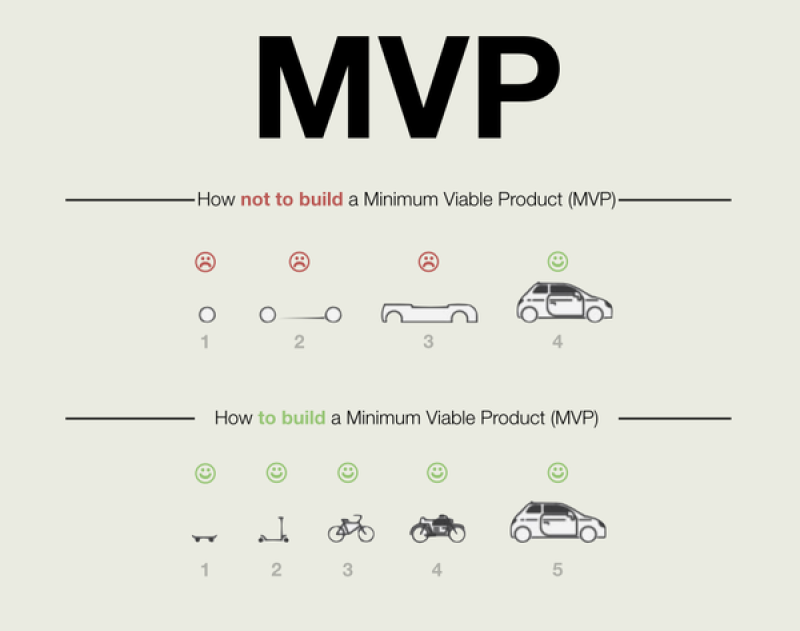In my last article, I briefly touched on Minimum Viable Product (MVP) and how the designation may affect how oil and gas companies view a new technology. By definition, “MVP is a product with just enough features to gather validated learning about the product and its continued development.”
The concept was introduced through lean startup methodology just a few years ago and has become popular with technology startups outside this industry. But can MVP be used successfully in the oil and gas arena too? The answer is yes, with some cautionary notes that will be discussed here.
What is purpose for MVP and how is it different than prototype?
An MVP needs to be mature enough in its development to perform its core function proficiently. The image below helps capture the concept at a high level. If the goal is to build a product with wheels that will help an individual move from point A to point B, then a skateboard could be considered a good place to start rather than a car chassis. This is because the skateboard still gets the main job done.

An MVP should not be confused with a prototype, which is used to showcase the vision of a new technology and to get potential stakeholders to jump on board. The MVP should be more practical and mature enough to get the job done, which typically means that it comes after a prototype has been produced.
Either way, most technologies will go through the MVP phase, which means that startups need to validate their customers’ needs as early as possible to ensure that the product-development roadmap is a match.
How to Be an MVP
in Oil and Gas
In some cases, operators will lose interest in a technology simply because it is considered an MVP, while others will be encouraged by the potential. Therefore, identifying the right partner for MVP feedback is critical.
One reason is that by default, oil and gas startups must work in a relatively constrained business-to-business model as opposed to a business-to-consumer model, of which the MVP target audience is far larger. With fewer end users, the ability to hone in on the most important needs of a potential client becomes more important.
I chose to use a hardware example and software example to show how an MVP could be designed:
| Problem | Solution | Main Feature | Additional Features |
|---|---|---|---|
| Operators get kicks and pressure shocks while making drilling string connections (due to loss of frictional pressure). | A choke that could trap pressure on connections. | Choke should be able to close fast enough on connections to trap pressure. | Choke could also apply back pressure while drilling |
| Choke is automated | |||
| Has a big screen on the choke panel and also in the driller’s cabin | |||
| Choke is certified for all rigs onshore US |
The main challenge here is to engineer the choke with its feature priority in mind. If the choke does not trap pressure, then simply put, none of the secondary features matter. This is where customer interviews will help technology developers understand what really matters.
The dilemma is that some of the added features may have different and sometimes opposite requirements. For example, for the choke to be fast-acting, the product may have to sacrifice the accuracy of applying back pressure. This is considered acceptable since it is not the primary function of the choke.
So the MVP in this case is a choke that will trap pressure better than any other choke on the market. That is the chief selling point; not an easier-to-read screen or field-to-office communications, etc. Those are soft features that anyone could attach to their product, and ones that should be applied to the new choke only after passing its specific litmus test, which is trapping pressure.
Below is an example of a software MVP:
| Problem | Solution | Main Feature | Additional Features |
|---|---|---|---|
| Updating the production forecast on a well-by-well basis takes a long time. | A software to automatically update production forecasts for all wells in a field. | The core algorithm can accurately update the production decline curve for several wells accurately. | A platform where operator personnel can log in, see the permitted well and write comments. |
| Software could also do economics | |||
| Software could also help with bookable reserves reporting. |
The novelty here is an algorithm that can deliver updated decline curves for several wells accurately. Everything else has been done before. The first version of the software product should focus on its ability to achieve its main value proposition and not the additional “nice to have” features.
Point here is, you could develop an MVP initially instead of the full-blown product. However, the main value proposition of your new technology should always be robust enough for an operator to try it. The ability to offer a test drive gives you an opportunity to gather feedback on what the user liked or disliked about the first
version and what other features they want to see added. More importantly, knowing how to be an MVP will avoid wasting a potential customer’s time, and your valuable resources, increasing the chances that your innovation will receive serious consideration.

Moji Karimi is an oil and gas entrepreneur who has helped ideate, develop, and commercialize technology for big companies such as Weatherford and has now begun focusing on startups. Currently, Karimi is the business development manager at Biota Technology, a startup that is commercializing DNA Sequencing in the oil and gas industry. He is also a cofounder of SPE Gulf Coast Section Entrepreneurship Cell which is an initiative to educate and connect entrepreneurs, decision makers, and investors. Karimi holds BS and MS degrees in drilling and petroleum engineering, respectively.

